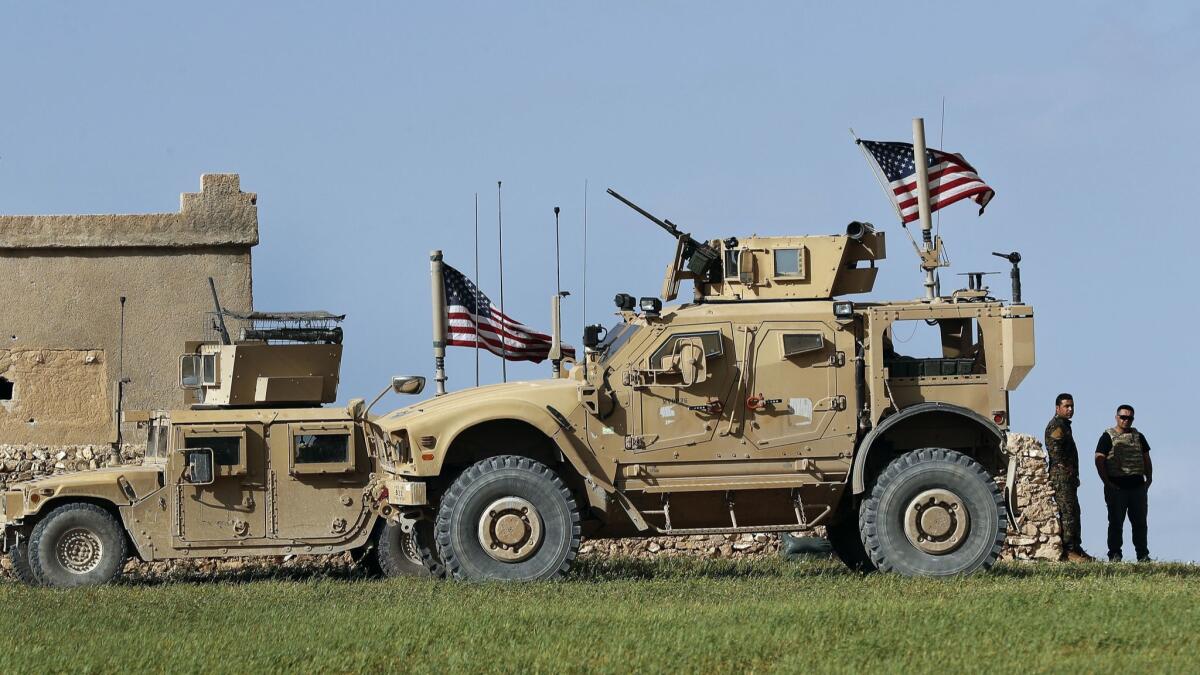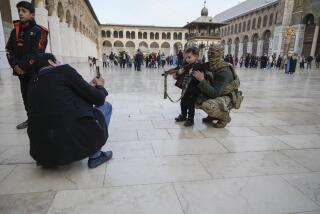U.S. to leave a ‘peacekeeping group’ of 200 troops in Syria, a step back from Trump’s order

- Share via
Reporting from Washington — The White House says “a small peacekeeping group of about 200” U.S. troops will stay in Syria beyond the planned withdrawal of American forces this spring.
The announcement Thursday by Press Secretary Sarah Huckabee Sanders did not specify where the troops would be based, what their responsibilities would be, or how long they would stay, beyond “a period of time.”
A U.S. official, speaking on the condition of anonymity to discuss details not yet made public, said the 200 would be “split down the middle” between Syrian Kurdish-controlled areas in the northeast of the country, and the Tanf garrison in southeast Syria. The official said the total might rise slightly.
The decision was a partial reversal of President Trump’s order, announced in December, that all 2,000 U.S. troops in Syria would leave because their mission to destroy Islamic State had been achieved. Complete withdrawal was expected by the end of April.
Defense officials, lawmakers and some White House aides have expressed concern that tens of thousands of militant fighters remained scattered throughout Syria and Iraq. France and Britain, which also have troops in Syria, rebuffed a U.S. request to leave forces there to continue operations against militant remnants and to patrol a “safe zone” along Syria’s northeastern border with Turkey unless some U.S. troops remained.
Turkey initially proposed the 20-mile safe zone to prevent what it says have been cross-border attacks by fighters of the Peoples’ Protection Units, the Kurdish forces that dominate the U.S.-allied Syrian ground force.
Turkey considers the Kurdish group terrorists, allied with Kurdish militants in that country, and has said it would attack them as soon as the Americans left. It has demanded their removal from the border area.
Sen. Lindsey Graham (R-S.C.) praised the move Thursday, and said that the residual U.S. force would “ensure that ISIS does not return and that Iran does not fill the vacuum that would have been left if we completely withdrew.” It also ensures, he said, that Turkey and the Syrian Kurds “will not go into conflict.” ISIS is an acronym for Islamic State.
Iran is a primary backer of Syrian President Bashar Assad, who wants to send his military forces, along with Iranian-commanded militias, into the eastern third of Syria now controlled by the U.S.-led coalition and its Syrian Kurdish allies.
“With this decision,” Graham said in a statement, “President Trump has decided to follow sound military advice.”
Graham has been among the loudest voices demanding that some troops be left in Syria. In a confrontation late last week with acting Defense Secretary Patrick Shanahan at the Munich Security Conference, he called the complete withdrawal “the dumbest ... thing I have ever heard,” and said that a U.S. commitment to patrol the border would provide an incentive to the Europeans to make their own commitments.
Senate Republicans break with Trump over plans to pull troops from Syria, Afghanistan »
While reluctant to disagree with Trump, U.S. military officials have repeatedly flagged what they see as the hazards of a hasty pullout, even after Islamic State’s territorial presence has been eliminated.
Britain and France did not immediately respond to the U.S. announcement Thursday.
Graham’s statement appeared to speak only to the safe zone, but some administration officials, including national security advisor John Bolton, had also pressed for troops to be left at the Tanf garrison, where they are seen as a bulwark against Iranian expansion.
The U.S. official said that Trump, Secretary of State Michael R. Pompeo and Shanahan had been in alignment on the plan for several weeks, but had wanted to enter discussions with the Europeans from a position of zero troops remaining, and “potentially go up” as they sought commitments from the allies.
Trump and Turkish President Recep Tayyip Erdogan, in a telephone call Thursday, “agreed to continue coordinating on the creation of a potential safe zone,” the White House said. Shanahan and Gen. Joseph F. Dunford Jr., chairman of the Joint Chiefs of Staff, are scheduled to meet with their Turkish counterparts in Washington on Friday.
Karen DeYoung and Missy Ryan write for the Washington Post. The Post’s Josh Dawsey contributed to this report.
More to Read
Sign up for Essential California
The most important California stories and recommendations in your inbox every morning.
You may occasionally receive promotional content from the Los Angeles Times.










